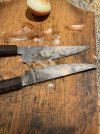Ok guys I need some help with something. I have a few chefs knives I’m working on that will be sent out to people and I don’t want them to have to deal with the shock of patina on a carbon steel knife, the situation is complicated so I can’t explain fully here. I’m looking for an even dark finish, I’m thinking etch in ferric and then in coffee. I’m wondering if I should skip the ferric and just do the coffee, if this process will give decent resistance to any shocking discoloration, as well as tips to improve the durability so it does not wear away the first time they use it and start leaving colors on their food. The steel is 80crv2 if that helps. I will obviously be giving a care sheet with the knife that explains the ins and outs of carbon steel knife care to minimize the worried emails that their knife is turning their tomatoes black and things of that nature.
In short, tips on getting a good protective layer on 80crv2 chefs knives, something durable that won’t wear super fast and that will not patina as noticeably. And definitely the best ways to make sure it’s not leaving colors on the food cut with it.
In short, tips on getting a good protective layer on 80crv2 chefs knives, something durable that won’t wear super fast and that will not patina as noticeably. And definitely the best ways to make sure it’s not leaving colors on the food cut with it.

